Swallow-tailed kites successfully raise young in Arkansas after 130-year absence
ON 09-16-2020
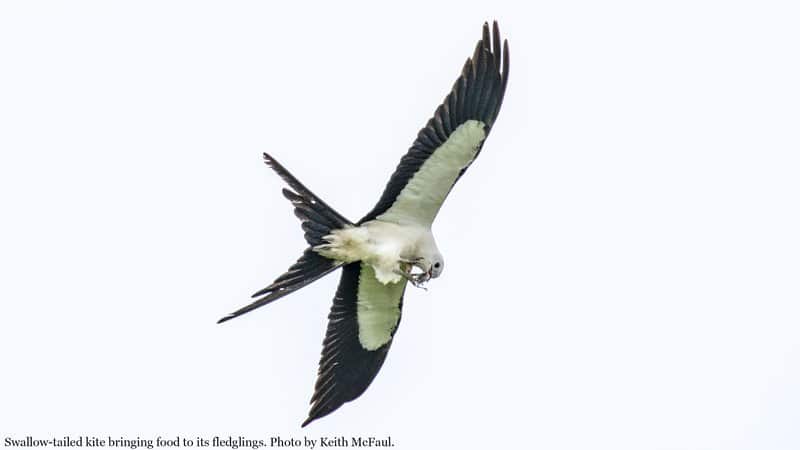
Sept. 16, 2020
Randy Zellers
Assistant Chief of Communications
FOUKE — With less than a year before his scheduled retirement, Mike Harris, an Arkansas Game and Fish Commission senior technician at Sulphur River Wildlife Management Area, completed a quest that’s been a decade in the making — documenting the first pair of swallow-tailed kites to successfully raise young in Arkansas since 1890. With the help of a live photo from an iPhone, showing adult kites feeding a fledgling, the Arkansas Audubon Society Bird Records Committee confirmed his finding in August.
Birders in Arkansas made headlines earlier this year when roseate spoonbills and white-faced ibis were recorded successfully nesting in Arkansas for the first time, but the reappearance of swallow-tailed kites raising young registers even higher among seasoned birders.
“This is probably the most significant development in Arkansas ornithological history since I’ve been birding,” said Charles Mills, an avid birder, photographer and former curator of bird records for the Arkansas Audubon Society. “During my birding, I’ve added species to Arkansas’s bird list, so I don’t get excited very often. But this has gotten me more energized than I can remember, and I only played an incidental role in this confirmation.”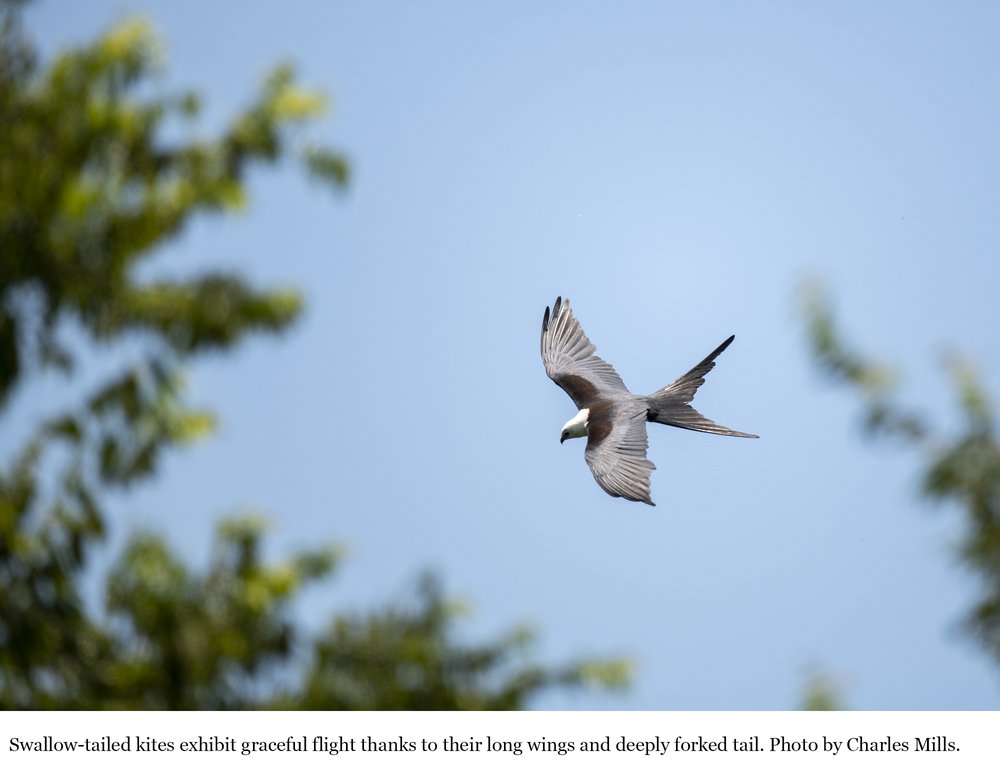
Mills accompanied Harris to capture images of a breeding pair of kites this summer after Harris sent Mills an image of the birds that showed a mature kite feeding a fledgling. He and fellow birder and photographer Keith McFaul made many subsequent trips to the area afterward to get more images.
“The actual picture used for confirmation didn’t show the markings needed to indicate the young bird was a fledgling,” Harris said. “But it was taken with an iPhone, and you could see the little snippet of video right before the photo pulled up that showed the adult coming into the limb where the fledgling was sitting. In those few moments you could see those markings. Charles was able to put that on a screen and video it again for us to send to an expert in Louisiana, who confirmed the successful nesting event.”
Recognized by birders as one of the most graceful flyers in the bird world, the swallow-tailed kite captivates anyone who witnesses its aerial acrobatics. Long wings and a deeply forked tail add to the coastal wetland bird’s maneuverability and ability to manipulate the wind with almost effortless precision. Its sleek profile and dove-shaped head belie its nature as a bird of prey, but it’s a predator of insects, reptiles and amphibians, small rodents, and smaller bird species. The species once ranged throughout much of the central and eastern U.S., including as many as 21 states. Its nesting range has been reduced to the states along the Gulf Coast and a few inland areas.
“We’ve documented swallow-tailed kites in Arkansas, as have other states, but successful breeding pairs have been absent for more than a century,” said Karen Rowe, nongame migratory bird program coordinator for the AGFC. “Wetland conversion to agriculture and harvest of timber within wetlands are largely thought to have impacted their range. They nest in super-dominant trees along the edges of the wetlands.”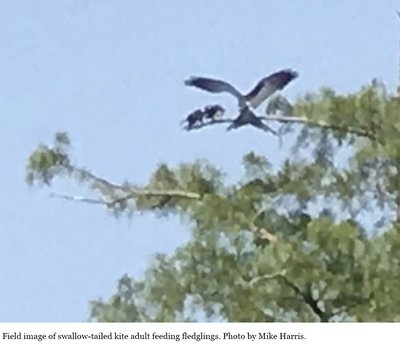
Rowe says the discovery is the icing on the cake to a year filled with birding discoveries in Arkansas.
“We found roseate spoonbills and white-faced ibis nesting this year, but these kites are just something to see,” Rowe said. “This is about 600 miles from the nearest known nesting site, and these birds aren’t known for expanding their range so Arkansas’ successful fledging event is of national avian conservation importance. And for Mike Harris to be the one to document it makes it even more special. He’s been chasing these birds, trying to find a nest for at least a decade.”
It was 1999 when Harris first heard of swallow-tailed kites in southwestern Arkansas.
“Someone said they saw some in the Red River bottoms, and that piqued my interest,” Harris said. “The first time we documented them on the [Sulphur River] WMA was in 2004.”
With 16,520 acres of intersecting bayous, bottomland hardwoods and wetlands with very little roads and disturbance, Sulphur River WMA is an ideal location for the birds to again set up shop. In addition to excellent deer and duck hunting, this gem is home to eagles, alligators and a variety of wetland species found in the warmer climates of Louisiana and Texas. The WMA was created in the early 1950s with wetland mitigation lands from the Army Corps of Engineers after the construction of Wright Patman Lake, just across the border in Texas. Later land purchases in the early 2000s completed the WMA’s current size.
Harris occasionally saw kites for the next few years and spoke often to Rowe about how he was finding them during May and June, the species’ breeding season. Rowe told him they really should pick up their efforts to monitor them and see if they were lucky enough for the birds to be nesting on his WMA.
“We got together with some of the other wildlife biologists and technicians in 2012 and started doing more formal documentation,” Harris said. “We were able to get our GIS division to start mapping out likely nest tree locations. J.P. Fairhead, who was our feral hog program coordinator, had done some work on these species during his college studies and really helped us formalize things and make the discovery happen.”
With the help of two helicopter surveys in 2015 and 2016 and modern technology, Harris and the team were able to narrow down that the birds were doing all the right things to be nesting on the WMA. All it would take is looking for that needle in the right haystack to make the discovery possible. They would have to literally catch the birds either going to or coming from the nest and hope luck was on their side. Ultimately, Harris was the one chosen by fortune.
“During COVID, I’ve been just as busy as I ever have been in the field,” Harris said. “I was actually baiting hog traps to remove feral hogs from the property and had taken a break to get away from the mosquitoes. Then I saw two juveniles with adults circling around and feeding them. I was able to get my phone out and capture some pictures, but it was the little video part at the front of the iPhone live photos that showed the actual feeding and the markings researchers needed to confirm the birds were fledglings from that year.”
Harris says fledgling swallow-tailed kites have a rusty brown color on their chests that gives them away. When he sent the image to Mills, they were able to zoom into the shot and get the details they needed.
With only a few months left in his career, Harris is ending on a high note, but he won’t abandon his accomplishment.
“I’m sure I’ll be back out there on my own next spring looking for them,” Harris said. “I may not be able to do it as extensively as I have during the last year, but I’ll be back.”
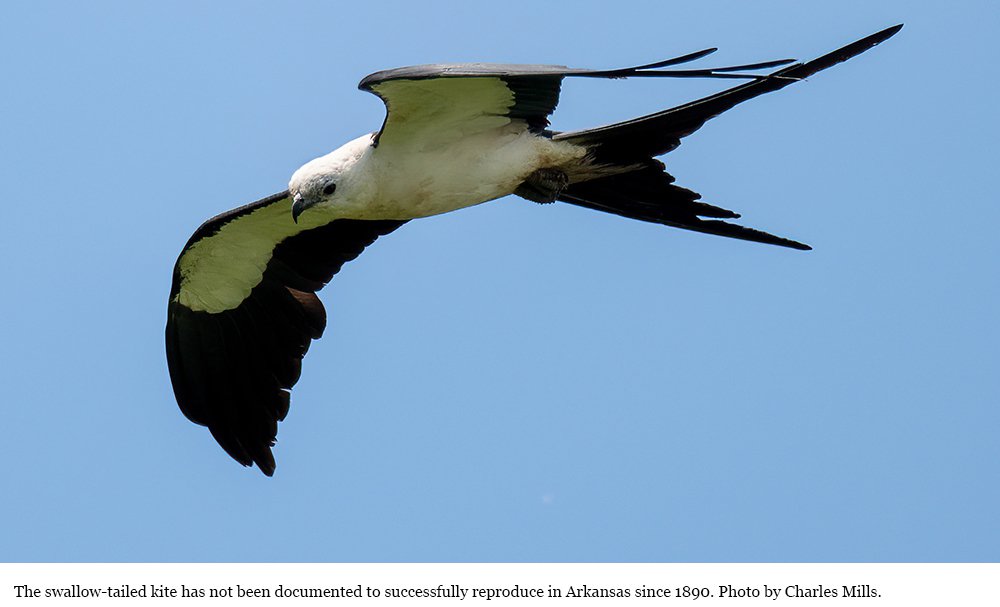
Recent News
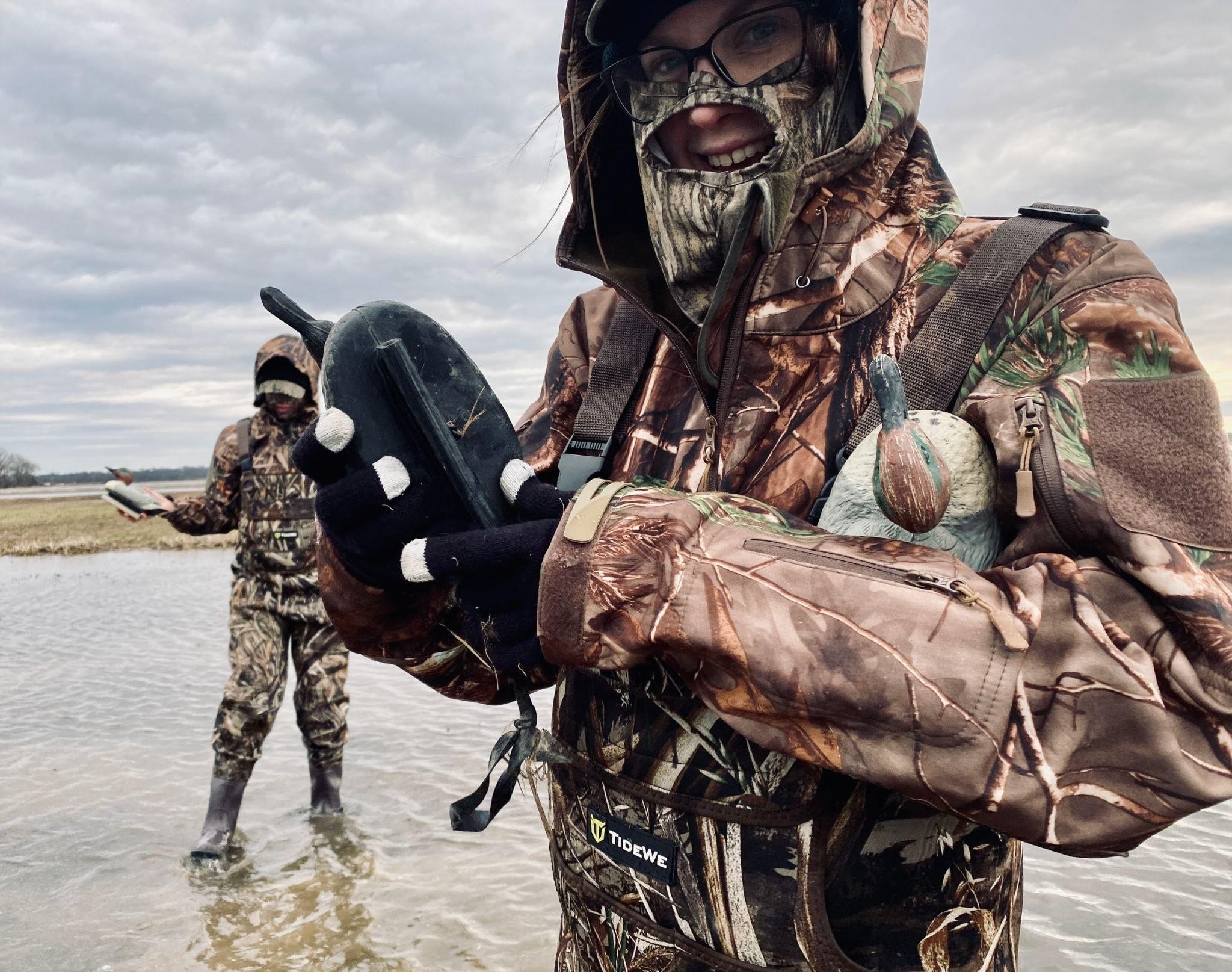
Waterfowl Report: Better Conditions Greet Hunters
Dec. 12, 2025
Subscribe to Our Weekly Newsletter E-mails
Don’t miss another issue. Sign up now to receive the AGFC Wildlife Weekly Newsletter in your mailbox every Wednesday afternoon (Waterfowl Reports are published weekly during waterfowl season and periodically outside the season). Fishing Reports arrive on Thursdays. Fill in the following fields and hit submit. Thanks, and welcome!

